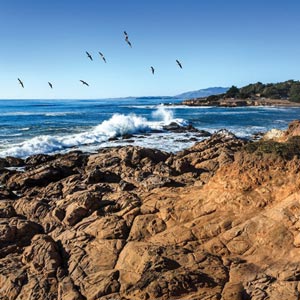Sierra Club advocates for Central Coast National Marine Sanctuary
-From the Sierra Club of California-
Economic impact of designation projected to exceed $23M annually, create at least 600 permanent new local jobs, report says

“The Potential Economic Impacts of the Proposed Central Coast National Marine Sanctuary” was prepared by Jason Scorse, Ph.D., Director of the Center for the Blue Economy at the Monterey Institute of International Studies (a Graduate School of Middlebury College) and Judith Kildow, Ph.D., director of the National Ocean Economics Program at the Center. Sierra Club California commissioned the report in response to an announcement earlier this year that the National Oceanic and Atmospheric Administration (NOAA) will begin considering new areas for National Marine Sanctuary designation for the first time since 1995.
“In most of the 14 current National Marine Sanctuaries, tourism is one of the largest sectors of the local economy. Millions of visitors are drawn to these areas for their beaches, recreational fishing, diving, snorkeling, surfing, wildlife viewing, and museums and aquariums,” Dr. Scorse and Dr. Kildow noted in their report.
Michael Thornton, an organizer with Sierra Club California, said, “San Luis Obispo has long been identified as a prime candidate for sanctuary designation. It sits nestled between the Channel Islands and Monterey Bay sanctuaries. Including this coastal region in the sanctuary system would provide an important connected stretch of coastline essential to the well-being of a wide variety of aquatic mammals, birds and other sea life. A healthier ocean benefits all of the species, including humans, that depend on it for their lives and livelihoods.”
Drivers for increased economic activity that accompany sanctuary designation include direct government expenditure on staffing, likely grant funding associated with research that would be conducted in the region and projected tourism-related revenue likely to be generated by the attractiveness of a protected coastline for recreational activities.
California has four National Marine Sanctuaries. The Channel Islands Sanctuary is far from the mainland in Southern California, the Monterey Bay Sanctuary is adjacent to a large population with a robust tourist economy, and Cordell Bank and the Gulf of the Farallones Sanctuaries are directly adjacent to each other and border much less dense populations. The report evaluated documented economic stimulus provided by each of these sanctuaries to estimate the likely economic benefits that would come to San Luis Obispo if it is successful in securing the designation.
NOAA announced in June that it is now approaching the process for identifying National Marine Sanctuaries in a new way. For a region to be considered for designation, a community must present its case to NOAA about why the nominated region is worthy of sanctuary status. Sierra Club is supporting the effort of local activists, businesses, and coastal tribes in making the case for sanctuary designation of the San Luis Obispo coastline.
The proposed sanctuary area, which also includes parts of northern Santa Barbara County, is home to kelp forests, the southern sea otter, gray whale migration routes and one of the most sustainable fisheries in the country including rock fish, salmon, sole, swordfish, and hundreds of non-commercial species. It also provides an important stopping point along the Pacific Flyway for migratory birds. The cold water off the coast and fresh water estuaries onshore make it an important nursery for a wide range of species. Offshore oil drilling, water pollution, seismic testing, and climate change all pose threats to the integrity of this diverse and valuable natural area.
Exploration for and production of oil, gas and minerals are banned in areas that are granted sanctuary designation. Regulations that govern economic activity that works in concert with the natural ecosystem, such as commercial fishing and recreational tourism, would be unaffected by a National Marine Sanctuary designation.
In the coming months, Sierra Club and other supporters will ask the San Luis Obispo Board of Supervisors to pass a resolution in favor of sanctuary status. A formal application is expected to be submitted to NOAA in the coming months.
Sierra Club California represents the Club’s 13 local chapters and 380,000 statewide members and supporters to protect California’s natural resources and to improve the health and safety of Californians.





















